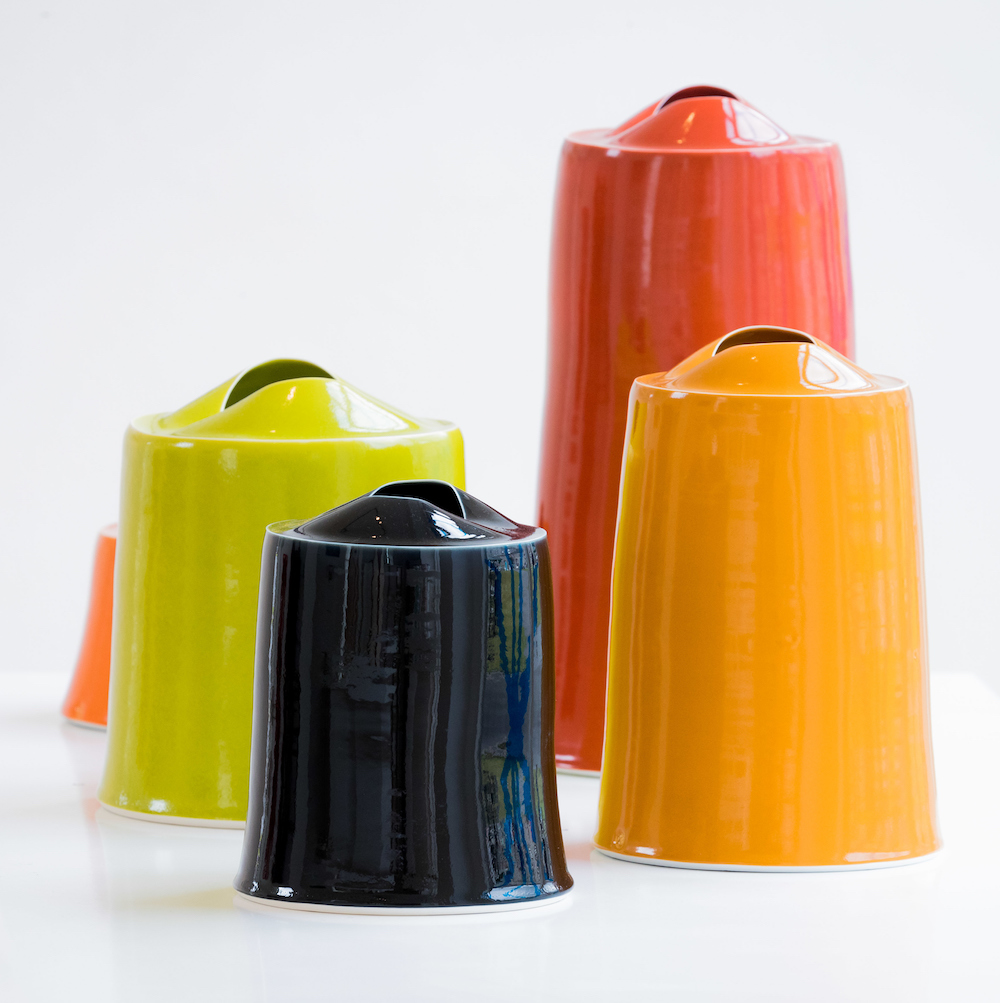KILKENNY, Ireland — Was the invitation to visit VASE: Function Reviewed at the National Craft Gallery, Kilkenny, Ireland (August 6 – November 6) an opportunity to see some beautiful vases or beautiful vessels?
Above image: Tanya Gomez at “VASE.”
A cursory glance through the historiography of ceramics reminds us that, throughout its complex history, the language surrounding objects of containment has frequently been revised and revisited; in ancient European and Asian dynasties, the vase predominated while in the nineteenth century, the Arts and Crafts Movement’s preference for simple, organic forms, resulted in the elevation of the art pot. In the twentieth century, the growth of the studio pottery movement in Britain, along with the increasingly conceptual approach taken by makers, led to the use of the, by now widely used word, vessel, as a medium of expression. In the latter half of the twentieth century, in a further evolution of this expression, vessels, when formed into groupings of objects, became installations.
The modern dictionary definition of “vase” suggests functionality, a container used to display flowers. However in VASE: Function Reviewed, curator Brian Kennedy’s first major ceramics exhibition at the National Craft Gallery, we see the vase through the lens of a number of leading ceramic artists who work in this increasingly fragmented field. We realize that “vase” is imbued with multiple meanings. For Northern Ireland-based maker Derek Wilson, the expression of communality and sociability take center stage, whether the work is intended to be used or not. However, it is also about minimalism and simplicity of form and while the notion of containment is ever present, its meaning is ambiguous, yet familiar and reassuring. Just beyond this, Andrew Wicks’ exploration of a symmetrical, odd numbered, grouping of objects, historically referred to as garnitures, provide an interesting juxtaposition of forms, which may be described as vases or vessels. Contrast this with a striking installation of five slip-cast porcelain vessels in pink, blue, white, cream and platinum by Natasha Daintry. Colour is central to Daintry’s practice and this bold grouping sees modern, lighter milky tones reacting to, and resisting, stronger colours.
For Anne Marie Laureys, who lives and works in Belgium, throwing a classic, symmetrical pot is just the beginning of her journey, a journey in which she takes time to find the true shape of a vessel. The result is unexpected, visceral and even uncomfortable at times, as her objects become a repository for emotions, feelings and life experiences. Jonathan Wade’s exploration of material permanence and impermanence also challenges the viewer while on the other hand, Agalis Manessi’s earthenware vases, appear gentle and comforting in soft pastel shades of blue, green and pink. Inspired by figures and animal studies from museum collections, they communicate easily.
The selection of ceramic artists from different backgrounds, cultures and experiences for this show has not only allowed for a wider investigation of a complex theme, it has also enabled the viewer to consider ceramics in many ways including the material culture of an object, historical context, process and material, consumer culture, as well as social signifier. We contrast the superb skill of Hwang Kap Sun’s minimalist cylindrical vases with Hitomo Hosono’s detailed forms. We see works that reference issues of identity, culture and class; Carol McNicoll’s work inhabits the safe environment of domesticity while commenting on excessive consumerism and politics. South African-born Ruan Hoffmann also draws on familiar objects, however the intent here is to comment, confront and provoke. His collection of containers, vases and jugs presented in this exhibition provides unedited observations on life’s experiences. The translation of stories into ceramic art, and especially the vase form, is one that has existed since ancient Greece. Helen Doherty, also born in South Africa but now living in Ireland, continues that tradition in her work. Combining decoration and form, her work explores the relationship between identity and place, gender and culture and while this narrative has also been played out on plates and sculptural ceramics, this exhibition sees the artist present a series of traditional vase forms and interesting half moon shapes inspired by both the Irish currach (traditional Irish wooden boat) and Dutch tulipier in a nod to the artist’s multi-cultural background.
For Irish audiences, this show places Irish ceramic artists alongside leading exponents of both modern and contemporary practice. VASE: Function Reviewed includes work by important names such as Alison Britton, Janice Tchalenko and Kate Malone however, the contribution of Irish makers to this exhibition is significant, most notably in Sara Flynn’s superbly confident Esker vessel installation, Alison Kay’s considered forms and Grainne Watts’ rotund vibrant vessels.
VASE: Function Reviewed, which formed part of the 2016 Kilkenny Arts Festival programme and is presented by the Design and Crafts Council of Ireland, can be seen at the National Craft Gallery, Kilkenny, Ireland until November 6th 2016 and Farmleigh Gallery, Dublin, Ireland from January 19th to February 26th 2017.
Frances McDonald is a contributor to cfile.daily.
Do you love or loathe these works of contemporary ceramic art? Let us know in the comments.















Add your valued opinion to this post.